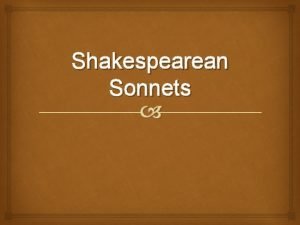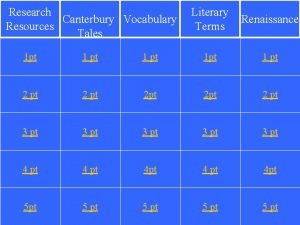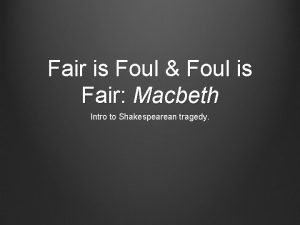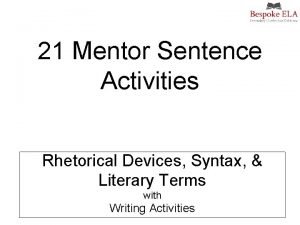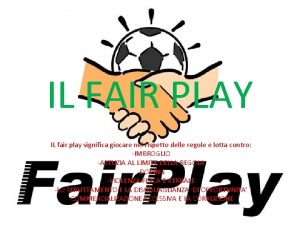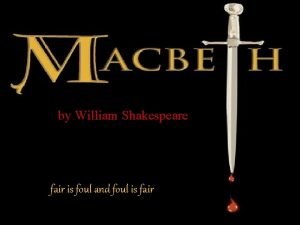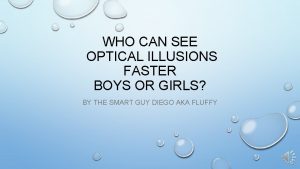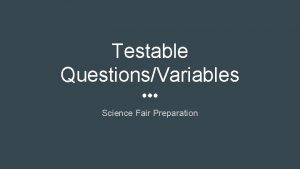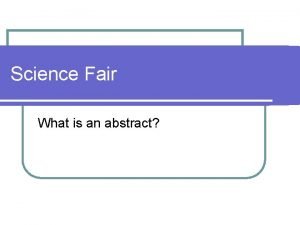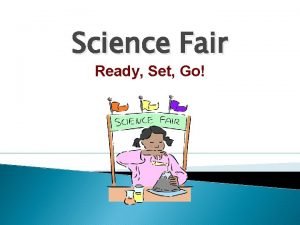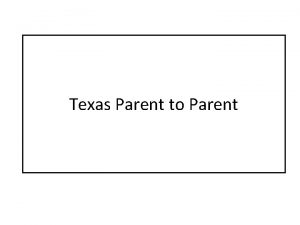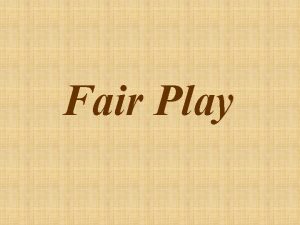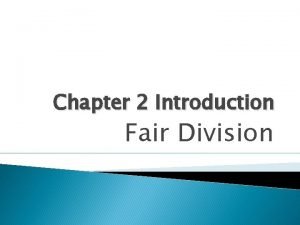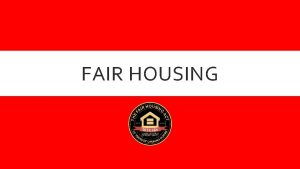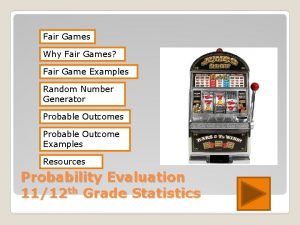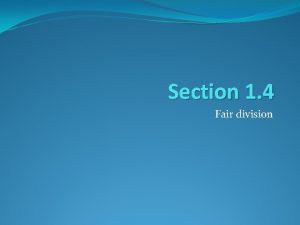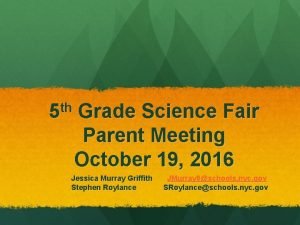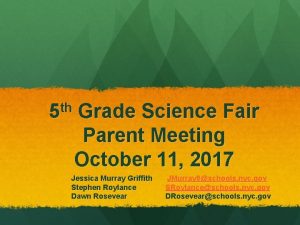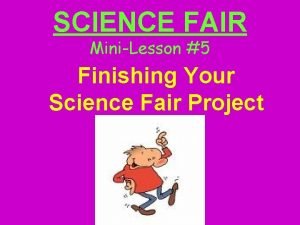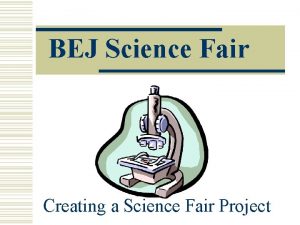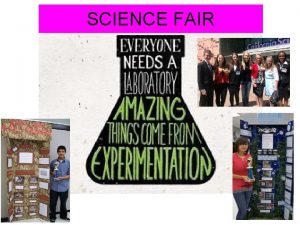Welcome to 5 th Grade Science Fair Parent
















- Slides: 16

Welcome to 5 th Grade Science Fair Parent Night Volcanoes ARE NOT allowed in 5 th grade

The Scientific Method 9 8 7 6 5 4 3 2 1 Make Applications Draw Conclusions from data Repeat the experiment Observe, record analyze data Perform the experiment Design an experiment Form a hypothesis Collect background information Identify the problem (Problem

DEVELOPING A SCIENCE PROJECT PROBLEM STATEMENT Step 1: Think of some science topics that interest you, or things you enjoy learning about. Examples are magnetism, light, biology, flight, etc. Step 2: Think of one question for each topic that you are interested in that lends itself to becoming an experiment. Experimental questions ask: • which is longer, faster, stronger or • compare one thing to another. Step 3: Consider the following when choosing your science project question: Which of those questions is most interesting? Can I perform an experiment, at a 5 th grade level, on that question at my home? Does that question compare two different things or methods to determine which is better? Now write a Problem Statement in the form of a question so that it is clear, understandable, and makes a comparison between two or more things. Example: Will banana’s on the counter brown faster than banana’s in the refrigerator?

COLLECTING BACKGROUND INFORMATION Step 1: Think of as many different topics as you can that are related to your question. For example, if your question is about temperature, you can look under the related subjects of thermodynamics, heat, thermometer, etc. Ask your teacher, parents and librarian for help. Step 2: Use at least three different sources for your research – these will be used as your bibliography. Step 3: Write a summary of what you have learned from your three sources.

SOURCE: BOOK TITLE: Encyclopedia Britannica Vol 4 BIBL HY IOGRAP AUTHOR, ENCYCLOPEDIA ARTICLE or WEBSITE: Encyclopedia PUBLISHER: Harper and Row CITY: New York PAGES: 56 -58 YEAR: 1988 INFORMATION FOUND: I found information about electrical circuits. There were directions on how to make an electrical circuit. SOURCE: BOOK TITLE: Electronics for children AUTHOR, ENCYCLOPEDIA ARTICLE or WEBSITE: es agazin books – s–m r e p a newsp Tucson Electric Power Company PUBLISHER: Houghton Mifflin CITY: New York PAGES: 37 -41 YEAR: 2007 INFORMATION FOUND: There were pictures and clear directions on how young children can make their own electrical circuit board. SOURCE: BOOK TITLE: Electrostatic Motor AUTHOR, ENCYCLOPEDIA ARTICLE or WEBSITE: www. scienceclub. org PUBLISHER: CITY: Bill Beaty THE SCIENCE CLUB YEAR: PAGES: INFORMATION FOUND: There were many different links to follow to help me find out about making an electrical circuit. It had directions to follow and gave a list of supplies that I would need. Yaho “web o and G s Your ites” the oogle a y webs child mu are sear re not ch s i able te addres t put dow engines to ac s wh. ere t n the cess h infor mati ey were on.

DEVELOPING A SCIENCE PROJECT HYPOTHESIS Now that you understand your project a little better, you have to guess what your experiment’s results will be. This is your hypothesis. A hypothesis is no ordinary guess. It is an “educated” guess, because you will use your background research to help you predict the results of your experiment before you actually begin the experiment process. PREDICTION: • What do you think will happen in your experiment? • What evidence do you have for this prediction? WRITING YOUR HYPOTHESIS: reword your prediction as an “If/then” statement. Be sure to include your evidence. Example: If I soak a name brand cereal and a generic brand cereal in milk then I predict that the generic cereal will get soggier faster.

DEVELOPING A PROJECT TITLE Ideally the title of your project should be catchy, an “interest-grabber, ” It should also describe the project well enough that people reading report can quickly figure out what you were studying. Although your project title when you were in 3 rd and 4 th grade could be the same as your Problem Statement… In 5 th grade your title must not be the same as your Problem Statement. Think of some titles you can use for your project and write them down so you can look at them and choose the best one. your

DESIGNING YOUR EXPERIMENT Before you can continue, you have to write your experiment down on paper. List the materials, procedure, controls and the one variable you will use in your experiment. MATERIALS: List all the materials you plan to use in your experiment. It is best to list them in column form. If you can, use the metric system. PROCEDURE: Write a step-by-step procedure of how to do your experiment. It needs to be very specific and simple enough that anyone can follow it, like a recipe in a cookbook. Some experiments need to be performed several times to ensure correct results; does yours? VARIABLE: What is the one thing in your experiment that is changed in order CONTROLS: In to solve your every experiment, there is a control group. problem statement. The control group has no changes added. You use the control group’s data to compare your results. List the parts of your experiment that you will use as your controls.

RECORDING YOUR DATA – PLANNING SHEET It is time to plan the methods you will use to record and display your data. You will need to keep a record or log of all the data you will gather in your experiment. The data log should be placed in your project notebook at the end of your experiment. • How will you record your results? bar graph, line graph, double bar or line graph, pie chart, photo timeline • What are you measuring? time, temperature, speed, heat, weight, etc. Draw a sketch of the graph you will make to show your results. Some results are best shown as a bar graph, some as a line graph, or a pie graph. Which graph is best for your experiment? Decide how you will label it. YOU ARE NOW READY TO PERFORM YOUR EXPERIMENT AND START TO RECORD YOUR DATA.

USING YOUR DATA TO ANALYZE/DRAW CONCLUSIONS FROM YOUR RESULTS/DATA Once you have completed your experiment, look carefully at the data you collected (your results). List as many things as you can that you learned from your data. Next write an analysis (a summary) of your data (your results). Be sure to make comparisons. Which one turned out to be: the longest strongest or what ever it is that you are measuring

WRITING YOUR CONCLUSION AND YOUR APPLICATION CONCLUSION: What is the answer to your science project Problem Statement? ANSWER: _____ Was your hypothesis correct? YES or NO How does your data support your answer? Write your conclusion paragraph. You should begin your conclusion by saying if your results agreed or disagreed with your hypothesis. You must answer your Problem Statement and give supporting evidence (data) for your answer. You may tell about any mistakes you may have made, what you would change if you could start over, and any new ideas your experiment has given you. APPLICATION: Write a short paragraph that tells how your project and its results can contribute to real life situations?

WRITING YOUR ABSTRACT The abstract is a brief overview of your project. It should include: TITLE OF MY PROJECT: Sample: DOES INSECTICIDE PROTECT LIMA BEAN PLANTS FROM INSECTS? PURPOSE: The purpose of this experiment was to determine if insecticides could protect lima bean plants from insects. HYPOTHESIS: The hypothesis was that if insecticide is sprayed on lima bean plants, then the plants would be protected from insects. PROCEDURE: Sixteen lima bean seeds were planted in 10” plant pots. All received the same amount of water and sunlight. Group A, plants 1 -8, was the control group and received no insecticide. Group B, plants 9 -16, were sprayed with insecticide twice a week beginning in the experiment’s second week. As the plants grew, they were checked daily for signs of harm by insects.

WRITING YOUR ABSTRACT - continued OBSERVATIONS: (What you saw) In week three, plants in Group A began to be affected by caterpillars. The insects continued to eat the plants. RESULTS and CONCLUSIONS: By the end of the experiment all the leaves of the plants in Groups A were eaten, and all but one of the plants had died. The plants in Group B were alive and free of harm from insects. It is concluded that insecticide does protect lima bean plants from insects. Therefore, the hypothesis was correct. The abstract should be about 150 words long. BIBLIOGRAPHY: (your 3 sources) This does not need to be placed on your board, but must be listed in your project notebook.

HELPFUL HINTS FOR THE DISPLAY TITLE – Make your display title BOARD SPELLING – EVERYTHING ON YOUR stand out. A good title can make someone want to know more about your project. Left side Be sure that your board has: A title – in the Middle section at the top Labels in the correct placement for the: Problem statement – top Left side Hypothesis – middle Left side Abstract – bottom Left side Data – surveys, charts, photos, drawings, graphs, etc. – Middle at the bottom Results – top Right side Conclusions – middle Right side Applications – bottom Right side Problem Statement BOARD SHOULD BE SPELLED CORRECTLY!!! Middle Title Hypothesis Abstract COLORFUL PRESENTATION – Help your display stand out. Use colorful headings, graphs, charts, and pictures. Label everything; a person should be able to understand each item without having to ask a question. DATA Surveys Graphs Charts Photos Right side Results Conclusion Applications PICTURES – Photos of your experiment should be used in your display. They can show some of your results or other important parts of your project. You may use actual photographs or drawings, BUT…if you chose to use photographs you may not use any photos that would show your face.

A FEW THINGS TO REMEMBER WHEN PUTTING YOUR BOARD TOGETHER: Your display should be created so that judges and other people can easily follow your experiment. ALL 5 th graders are expected to use their laptop to type the information for the project board. They may chose to use their laptop to type the project notebook. You may not use pictures that would show your face or the face of anyone in your family. You can show the back of your head, hands, feet, etc – just NOT faces. Your name may not appear anywhere on the front of the board.

QUESTION S
 Sonnet with 14 lines
Sonnet with 14 lines Foul is fair and fair is foul literary device
Foul is fair and fair is foul literary device Examples of aside in macbeth
Examples of aside in macbeth Fair is foul and foul is fair macbeth
Fair is foul and foul is fair macbeth Syntax rhetorical device
Syntax rhetorical device Fair play significado
Fair play significado Examples of fair is foul and foul is fair in macbeth
Examples of fair is foul and foul is fair in macbeth Welcome to parent orientation
Welcome to parent orientation Welcome to parent orientation
Welcome to parent orientation Kindergarten orientation speech
Kindergarten orientation speech What your favorite subject
What your favorite subject Wise men three clever are we
Wise men three clever are we Conclusion of optical illusion
Conclusion of optical illusion Science fair abstract example
Science fair abstract example Testable science questions
Testable science questions Science fair project abstract
Science fair project abstract Science fair project timeline
Science fair project timeline
